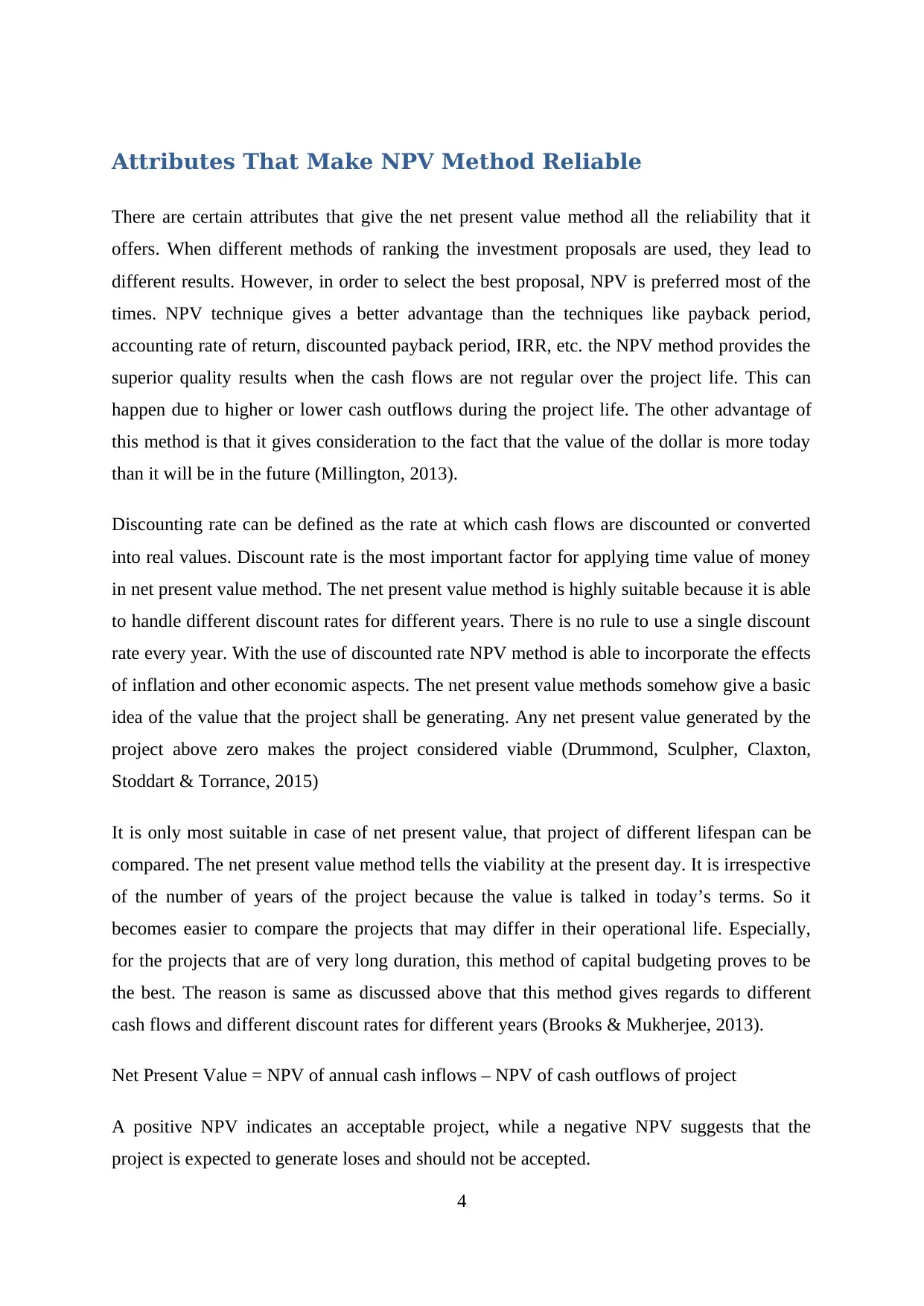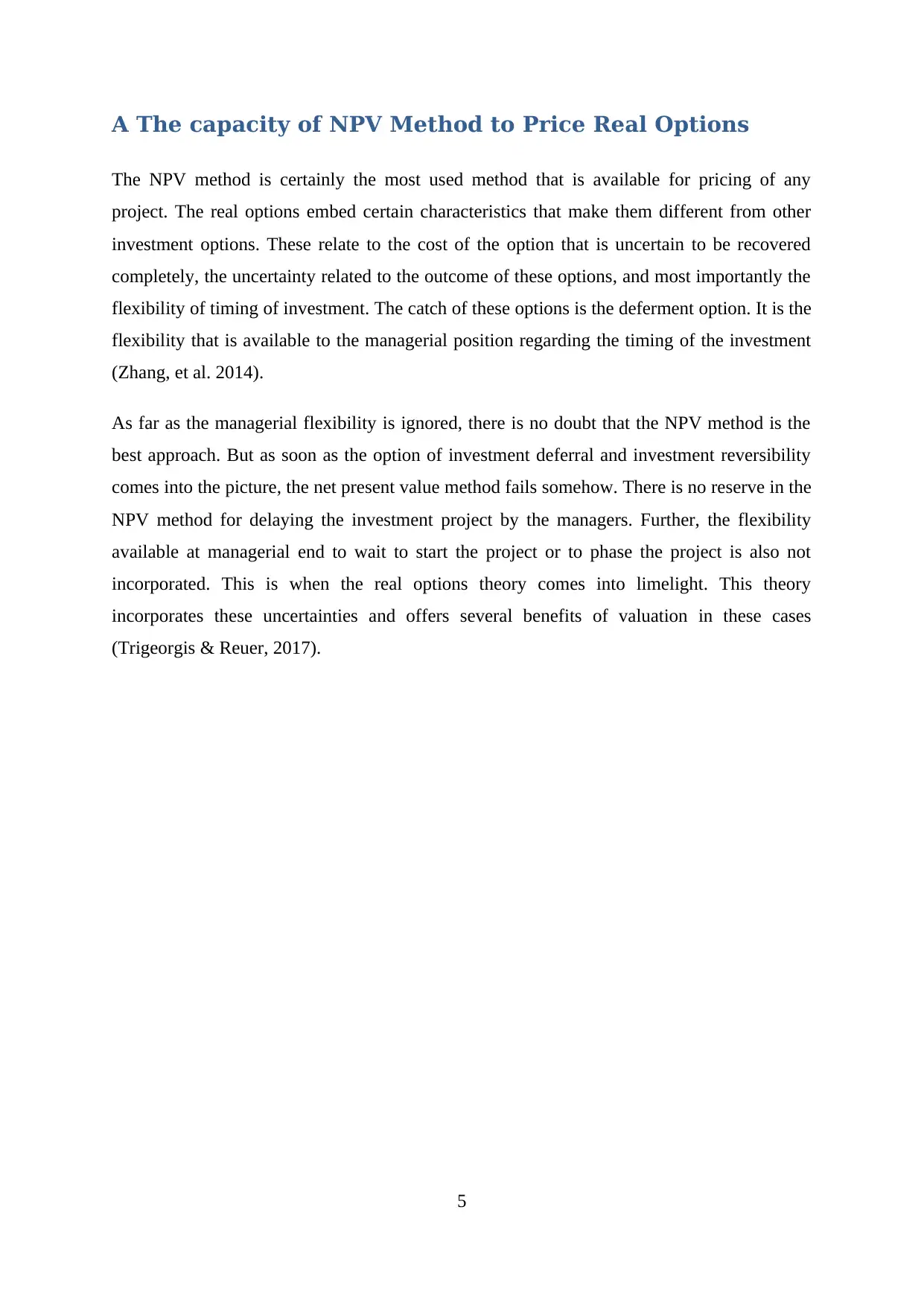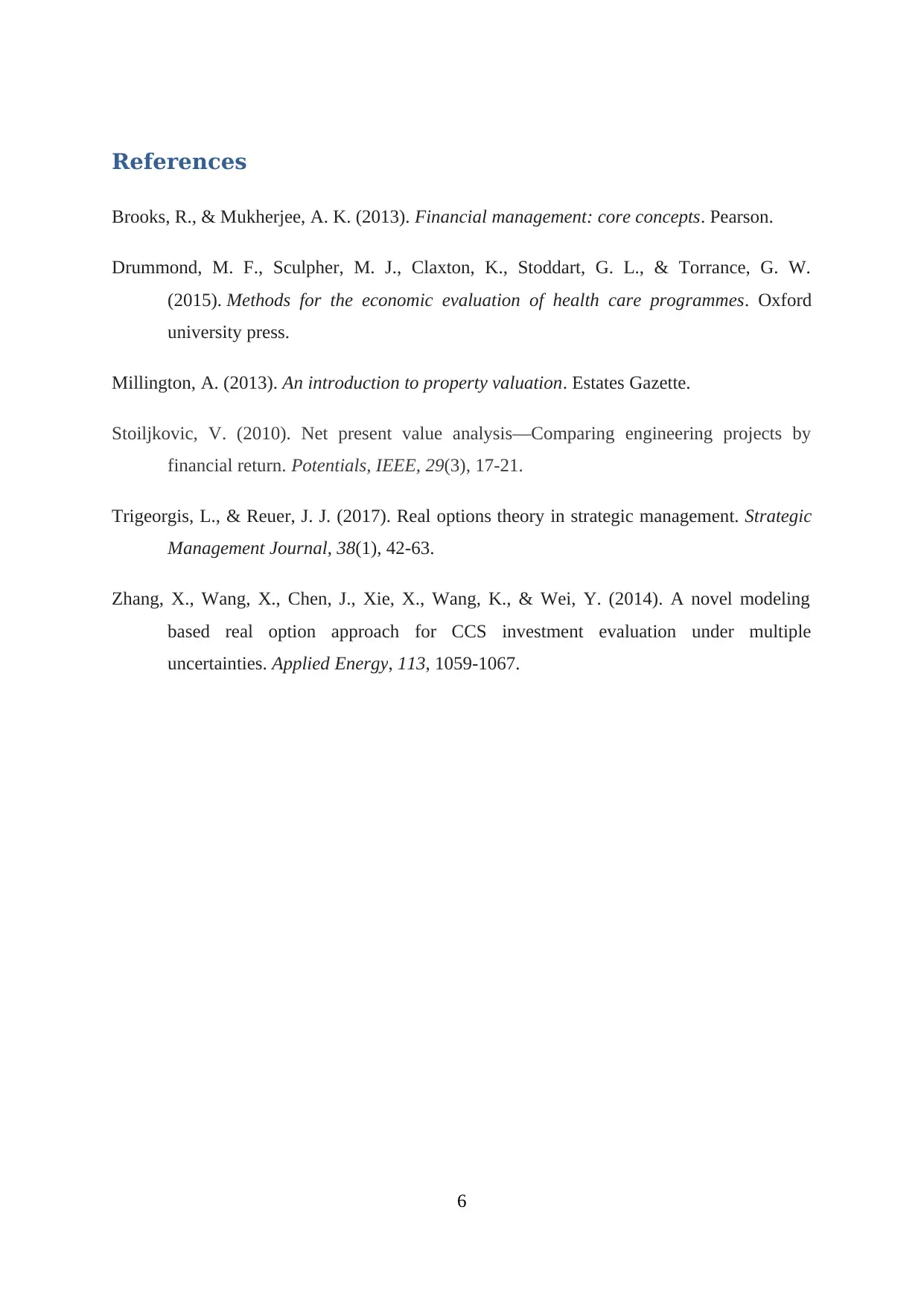Capital Budgeting: NPV Analysis, Attributes, and Real Options
VerifiedAdded on 2021/04/16
|6
|1031
|31
Report
AI Summary
This report provides a detailed analysis of the Net Present Value (NPV) method, a crucial capital budgeting technique. It begins by introducing NPV and its role in evaluating capital projects, emphasizing its ability to determine project profitability based on positive or negative NPV calculations. The report then delves into the attributes that make NPV a reliable method, highlighting its superiority over other techniques like payback period and IRR, especially when dealing with irregular cash flows. It also discusses the importance of the discount rate in incorporating the time value of money and handling inflation. Furthermore, the report explores the capacity of the NPV method to price real options, acknowledging its limitations when managerial flexibility is considered, and introducing the real options theory as a complementary approach. The report concludes by emphasizing the use of NPV for comparing projects of different lifespans and the benefits of the method in the context of long-duration projects, with the inclusion of the references used.

NET PRESENT VALUE
1
1
Paraphrase This Document
Need a fresh take? Get an instant paraphrase of this document with our AI Paraphraser

Table of Contents
Introduction................................................................................................................................3
Attributes That Make NPV Method Reliable.............................................................................4
A The capacity of NPV Method to Price Real Options.............................................................5
References..................................................................................................................................6
2
Introduction................................................................................................................................3
Attributes That Make NPV Method Reliable.............................................................................4
A The capacity of NPV Method to Price Real Options.............................................................5
References..................................................................................................................................6
2

Introduction
Capital budgeting technique is used to analyse capital projects undertaken. Net present value
is one of the most popular capital budgeting techniques. It is used in making the capital
budgeting decision. The viability of the profitability of any project is decided using this
technique. The basic rule is that, if a project has resulted in the calculation of positive NPV
then the decision to invest in the same shall turn profitable. But if the project has provided
negative NPV, then the decision to invest in the same might lead to losses for the company
(Stoiljkovic, 2010)
3
Capital budgeting technique is used to analyse capital projects undertaken. Net present value
is one of the most popular capital budgeting techniques. It is used in making the capital
budgeting decision. The viability of the profitability of any project is decided using this
technique. The basic rule is that, if a project has resulted in the calculation of positive NPV
then the decision to invest in the same shall turn profitable. But if the project has provided
negative NPV, then the decision to invest in the same might lead to losses for the company
(Stoiljkovic, 2010)
3
⊘ This is a preview!⊘
Do you want full access?
Subscribe today to unlock all pages.

Trusted by 1+ million students worldwide

Attributes That Make NPV Method Reliable
There are certain attributes that give the net present value method all the reliability that it
offers. When different methods of ranking the investment proposals are used, they lead to
different results. However, in order to select the best proposal, NPV is preferred most of the
times. NPV technique gives a better advantage than the techniques like payback period,
accounting rate of return, discounted payback period, IRR, etc. the NPV method provides the
superior quality results when the cash flows are not regular over the project life. This can
happen due to higher or lower cash outflows during the project life. The other advantage of
this method is that it gives consideration to the fact that the value of the dollar is more today
than it will be in the future (Millington, 2013).
Discounting rate can be defined as the rate at which cash flows are discounted or converted
into real values. Discount rate is the most important factor for applying time value of money
in net present value method. The net present value method is highly suitable because it is able
to handle different discount rates for different years. There is no rule to use a single discount
rate every year. With the use of discounted rate NPV method is able to incorporate the effects
of inflation and other economic aspects. The net present value methods somehow give a basic
idea of the value that the project shall be generating. Any net present value generated by the
project above zero makes the project considered viable (Drummond, Sculpher, Claxton,
Stoddart & Torrance, 2015)
It is only most suitable in case of net present value, that project of different lifespan can be
compared. The net present value method tells the viability at the present day. It is irrespective
of the number of years of the project because the value is talked in today’s terms. So it
becomes easier to compare the projects that may differ in their operational life. Especially,
for the projects that are of very long duration, this method of capital budgeting proves to be
the best. The reason is same as discussed above that this method gives regards to different
cash flows and different discount rates for different years (Brooks & Mukherjee, 2013).
Net Present Value = NPV of annual cash inflows – NPV of cash outflows of project
A positive NPV indicates an acceptable project, while a negative NPV suggests that the
project is expected to generate loses and should not be accepted.
4
There are certain attributes that give the net present value method all the reliability that it
offers. When different methods of ranking the investment proposals are used, they lead to
different results. However, in order to select the best proposal, NPV is preferred most of the
times. NPV technique gives a better advantage than the techniques like payback period,
accounting rate of return, discounted payback period, IRR, etc. the NPV method provides the
superior quality results when the cash flows are not regular over the project life. This can
happen due to higher or lower cash outflows during the project life. The other advantage of
this method is that it gives consideration to the fact that the value of the dollar is more today
than it will be in the future (Millington, 2013).
Discounting rate can be defined as the rate at which cash flows are discounted or converted
into real values. Discount rate is the most important factor for applying time value of money
in net present value method. The net present value method is highly suitable because it is able
to handle different discount rates for different years. There is no rule to use a single discount
rate every year. With the use of discounted rate NPV method is able to incorporate the effects
of inflation and other economic aspects. The net present value methods somehow give a basic
idea of the value that the project shall be generating. Any net present value generated by the
project above zero makes the project considered viable (Drummond, Sculpher, Claxton,
Stoddart & Torrance, 2015)
It is only most suitable in case of net present value, that project of different lifespan can be
compared. The net present value method tells the viability at the present day. It is irrespective
of the number of years of the project because the value is talked in today’s terms. So it
becomes easier to compare the projects that may differ in their operational life. Especially,
for the projects that are of very long duration, this method of capital budgeting proves to be
the best. The reason is same as discussed above that this method gives regards to different
cash flows and different discount rates for different years (Brooks & Mukherjee, 2013).
Net Present Value = NPV of annual cash inflows – NPV of cash outflows of project
A positive NPV indicates an acceptable project, while a negative NPV suggests that the
project is expected to generate loses and should not be accepted.
4
Paraphrase This Document
Need a fresh take? Get an instant paraphrase of this document with our AI Paraphraser

A The capacity of NPV Method to Price Real Options
The NPV method is certainly the most used method that is available for pricing of any
project. The real options embed certain characteristics that make them different from other
investment options. These relate to the cost of the option that is uncertain to be recovered
completely, the uncertainty related to the outcome of these options, and most importantly the
flexibility of timing of investment. The catch of these options is the deferment option. It is the
flexibility that is available to the managerial position regarding the timing of the investment
(Zhang, et al. 2014).
As far as the managerial flexibility is ignored, there is no doubt that the NPV method is the
best approach. But as soon as the option of investment deferral and investment reversibility
comes into the picture, the net present value method fails somehow. There is no reserve in the
NPV method for delaying the investment project by the managers. Further, the flexibility
available at managerial end to wait to start the project or to phase the project is also not
incorporated. This is when the real options theory comes into limelight. This theory
incorporates these uncertainties and offers several benefits of valuation in these cases
(Trigeorgis & Reuer, 2017).
5
The NPV method is certainly the most used method that is available for pricing of any
project. The real options embed certain characteristics that make them different from other
investment options. These relate to the cost of the option that is uncertain to be recovered
completely, the uncertainty related to the outcome of these options, and most importantly the
flexibility of timing of investment. The catch of these options is the deferment option. It is the
flexibility that is available to the managerial position regarding the timing of the investment
(Zhang, et al. 2014).
As far as the managerial flexibility is ignored, there is no doubt that the NPV method is the
best approach. But as soon as the option of investment deferral and investment reversibility
comes into the picture, the net present value method fails somehow. There is no reserve in the
NPV method for delaying the investment project by the managers. Further, the flexibility
available at managerial end to wait to start the project or to phase the project is also not
incorporated. This is when the real options theory comes into limelight. This theory
incorporates these uncertainties and offers several benefits of valuation in these cases
(Trigeorgis & Reuer, 2017).
5

References
Brooks, R., & Mukherjee, A. K. (2013). Financial management: core concepts. Pearson.
Drummond, M. F., Sculpher, M. J., Claxton, K., Stoddart, G. L., & Torrance, G. W.
(2015). Methods for the economic evaluation of health care programmes. Oxford
university press.
Millington, A. (2013). An introduction to property valuation. Estates Gazette.
Stoiljkovic, V. (2010). Net present value analysis—Comparing engineering projects by
financial return. Potentials, IEEE, 29(3), 17-21.
Trigeorgis, L., & Reuer, J. J. (2017). Real options theory in strategic management. Strategic
Management Journal, 38(1), 42-63.
Zhang, X., Wang, X., Chen, J., Xie, X., Wang, K., & Wei, Y. (2014). A novel modeling
based real option approach for CCS investment evaluation under multiple
uncertainties. Applied Energy, 113, 1059-1067.
6
Brooks, R., & Mukherjee, A. K. (2013). Financial management: core concepts. Pearson.
Drummond, M. F., Sculpher, M. J., Claxton, K., Stoddart, G. L., & Torrance, G. W.
(2015). Methods for the economic evaluation of health care programmes. Oxford
university press.
Millington, A. (2013). An introduction to property valuation. Estates Gazette.
Stoiljkovic, V. (2010). Net present value analysis—Comparing engineering projects by
financial return. Potentials, IEEE, 29(3), 17-21.
Trigeorgis, L., & Reuer, J. J. (2017). Real options theory in strategic management. Strategic
Management Journal, 38(1), 42-63.
Zhang, X., Wang, X., Chen, J., Xie, X., Wang, K., & Wei, Y. (2014). A novel modeling
based real option approach for CCS investment evaluation under multiple
uncertainties. Applied Energy, 113, 1059-1067.
6
⊘ This is a preview!⊘
Do you want full access?
Subscribe today to unlock all pages.

Trusted by 1+ million students worldwide
1 out of 6
Related Documents
Your All-in-One AI-Powered Toolkit for Academic Success.
+13062052269
info@desklib.com
Available 24*7 on WhatsApp / Email
![[object Object]](/_next/static/media/star-bottom.7253800d.svg)
Unlock your academic potential
Copyright © 2020–2025 A2Z Services. All Rights Reserved. Developed and managed by ZUCOL.





